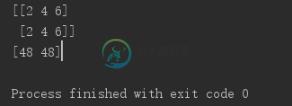浅谈keras中的后端backend及其相关函数(K.prod,K.cast)
一、K.prod
prod
keras.backend.prod(x, axis=None, keepdims=False)
功能:在某一指定轴,计算张量中的值的乘积。
参数
x: 张量或变量。
axis: 一个整数需要计算乘积的轴。
keepdims: 布尔值,是否保留原尺寸。 如果 keepdims 为 False,则张量的秩减 1。 如果 keepdims 为 True,缩小的维度保留为长度 1。
返回
x 的元素的乘积的张量。
Numpy 实现
def prod(x, axis=None, keepdims=False):
if isinstance(axis, list):
axis = tuple(axis)
return np.prod(x, axis=axis, keepdims=keepdims)
具体例子:
import numpy as np x=np.array([[2,4,6],[2,4,6]]) scaling = np.prod(x, axis=1, keepdims=False) print(x) print(scaling)
【运行结果】

二、K.cast
cast
keras.backend.cast(x, dtype)
功能:将张量转换到不同的 dtype 并返回。
你可以转换一个 Keras 变量,但它仍然返回一个 Keras 张量。
参数
x: Keras 张量(或变量)。
dtype: 字符串, ('float16', 'float32' 或 'float64')。
返回
Keras 张量,类型为 dtype。
例子
>>> from keras import backend as K >>> input = K.placeholder((2, 3), dtype='float32') >>> input <tf.Tensor 'Placeholder_2:0' shape=(2, 3) dtype=float32> # It doesn't work in-place as below. >>> K.cast(input, dtype='float16') <tf.Tensor 'Cast_1:0' shape=(2, 3) dtype=float16> >>> input <tf.Tensor 'Placeholder_2:0' shape=(2, 3) dtype=float32> # you need to assign it. >>> input = K.cast(input, dtype='float16') >>> input <tf.Tensor 'Cast_2:0' shape=(2, 3) dtype=float16>
补充知识:keras源码之backend库目录
backend库目录
先看common.py
一上来是一些说明
# the type of float to use throughout the session. 整个模块都是用浮点型数据 _FLOATX = 'float32' # 数据类型为32位浮点型 _EPSILON = 1e-7 # 很小的常数 _IMAGE_DATA_FORMAT = 'channels_last' # 图像数据格式 最后显示通道,tensorflow格式
接下来看里面的一些函数
def epsilon():
"""Returns the value of the fuzz factor used in numeric expressions.
返回数值表达式中使用的模糊因子的值
# Returns
A float.
# Example
```python
>>> keras.backend.epsilon()
1e-07
```
"""
return _EPSILON
该函数定义了一个常量,值为1e-07,在终端可以直接输出,如下:

def set_epsilon(e):
"""Sets the value of the fuzz factor used in numeric expressions.
# Arguments
e: float. New value of epsilon.
# Example
```python
>>> from keras import backend as K
>>> K.epsilon()
1e-07
>>> K.set_epsilon(1e-05)
>>> K.epsilon()
1e-05
```
"""
global _EPSILON
_EPSILON = e
该函数允许自定义值

以string的形式返回默认的浮点类型:
def floatx():
"""Returns the default float type, as a string.
(e.g. 'float16', 'float32', 'float64').
# Returns
String, the current default float type.
# Example
```python
>>> keras.backend.floatx()
'float32'
```
"""
return _FLOATX

把numpy数组投影到默认的浮点类型:
def cast_to_floatx(x): """Cast a Numpy array to the default Keras float type.把numpy数组投影到默认的浮点类型 # Arguments x: Numpy array. # Returns The same Numpy array, cast to its new type. # Example ```python >>> from keras import backend as K >>> K.floatx() 'float32' >>> arr = numpy.array([1.0, 2.0], dtype='float64') >>> arr.dtype dtype('float64') >>> new_arr = K.cast_to_floatx(arr) >>> new_arr array([ 1., 2.], dtype=float32) >>> new_arr.dtype dtype('float32') ``` """ return np.asarray(x, dtype=_FLOATX)
默认数据格式、自定义数据格式和检查数据格式:
def image_data_format():
"""Returns the default image data format convention ('channels_first' or 'channels_last').
# Returns
A string, either `'channels_first'` or `'channels_last'`
# Example
```python
>>> keras.backend.image_data_format()
'channels_first'
```
"""
return _IMAGE_DATA_FORMAT
def set_image_data_format(data_format):
"""Sets the value of the data format convention.
# Arguments
data_format: string. `'channels_first'` or `'channels_last'`.
# Example
```python
>>> from keras import backend as K
>>> K.image_data_format()
'channels_first'
>>> K.set_image_data_format('channels_last')
>>> K.image_data_format()
'channels_last'
```
"""
global _IMAGE_DATA_FORMAT
if data_format not in {'channels_last', 'channels_first'}:
raise ValueError('Unknown data_format:', data_format)
_IMAGE_DATA_FORMAT = str(data_format)
def normalize_data_format(value):
"""Checks that the value correspond to a valid data format.
# Arguments
value: String or None. `'channels_first'` or `'channels_last'`.
# Returns
A string, either `'channels_first'` or `'channels_last'`
# Example
```python
>>> from keras import backend as K
>>> K.normalize_data_format(None)
'channels_first'
>>> K.normalize_data_format('channels_last')
'channels_last'
```
# Raises
ValueError: if `value` or the global `data_format` invalid.
"""
if value is None:
value = image_data_format()
data_format = value.lower()
if data_format not in {'channels_first', 'channels_last'}:
raise ValueError('The `data_format` argument must be one of '
'"channels_first", "channels_last". Received: ' +
str(value))
return data_format
剩余的关于维度顺序和数据格式的方法:
def set_image_dim_ordering(dim_ordering):
"""Legacy setter for `image_data_format`.
# Arguments
dim_ordering: string. `tf` or `th`.
# Example
```python
>>> from keras import backend as K
>>> K.image_data_format()
'channels_first'
>>> K.set_image_data_format('channels_last')
>>> K.image_data_format()
'channels_last'
```
# Raises
ValueError: if `dim_ordering` is invalid.
"""
global _IMAGE_DATA_FORMAT
if dim_ordering not in {'tf', 'th'}:
raise ValueError('Unknown dim_ordering:', dim_ordering)
if dim_ordering == 'th':
data_format = 'channels_first'
else:
data_format = 'channels_last'
_IMAGE_DATA_FORMAT = data_format
def image_dim_ordering():
"""Legacy getter for `image_data_format`.
# Returns
string, one of `'th'`, `'tf'`
"""
if _IMAGE_DATA_FORMAT == 'channels_first':
return 'th'
else:
return 'tf'
在common.py之后有三个backend,分别是cntk,tensorflow和theano。
__init__.py
首先从common.py中引入了所有需要的东西
from .common import epsilon from .common import floatx from .common import set_epsilon from .common import set_floatx from .common import cast_to_floatx from .common import image_data_format from .common import set_image_data_format from .common import normalize_data_format
接下来是检查环境变量与配置文件,设置backend和format,默认的backend是tensorflow。
# Set Keras base dir path given KERAS_HOME env variable, if applicable.
# Otherwise either ~/.keras or /tmp.
if 'KERAS_HOME' in os.environ: # 环境变量
_keras_dir = os.environ.get('KERAS_HOME')
else:
_keras_base_dir = os.path.expanduser('~')
if not os.access(_keras_base_dir, os.W_OK):
_keras_base_dir = '/tmp'
_keras_dir = os.path.join(_keras_base_dir, '.keras')
# Default backend: TensorFlow. 默认后台是TensorFlow
_BACKEND = 'tensorflow'
# Attempt to read Keras config file.读取keras配置文件
_config_path = os.path.expanduser(os.path.join(_keras_dir, 'keras.json'))
if os.path.exists(_config_path):
try:
with open(_config_path) as f:
_config = json.load(f)
except ValueError:
_config = {}
_floatx = _config.get('floatx', floatx())
assert _floatx in {'float16', 'float32', 'float64'}
_epsilon = _config.get('epsilon', epsilon())
assert isinstance(_epsilon, float)
_backend = _config.get('backend', _BACKEND)
_image_data_format = _config.get('image_data_format',
image_data_format())
assert _image_data_format in {'channels_last', 'channels_first'}
set_floatx(_floatx)
set_epsilon(_epsilon)
set_image_data_format(_image_data_format)
_BACKEND = _backend
之后的tensorflow_backend.py文件是一些tensorflow中的函数说明,详细内容请参考tensorflow有关资料。
以上这篇浅谈keras中的后端backend及其相关函数(K.prod,K.cast)就是小编分享给大家的全部内容了,希望能给大家一个参考,也希望大家多多支持小牛知识库。
-
本文向大家介绍浅谈JavaScript的函数及作用域,包括了浅谈JavaScript的函数及作用域的使用技巧和注意事项,需要的朋友参考一下 函数和作用域是JavaScript的重要组成部分,我们在使用JavaScript编写程序的过程中经常要用到这两部分内容,作为初学者,我经常有困惑,借助写此博文来巩固下之前学习的内容。 (一)JavaScript函数 JavaScript函数是指一个特定代码块,
-
本文向大家介绍浅谈keras中的keras.utils.to_categorical用法,包括了浅谈keras中的keras.utils.to_categorical用法的使用技巧和注意事项,需要的朋友参考一下 如下所示: to_categorical(y, num_classes=None, dtype='float32') 将整型标签转为onehot。y为int数组,num_classes为标
-
本文向大家介绍浅谈Shell中的函数,包括了浅谈Shell中的函数的使用技巧和注意事项,需要的朋友参考一下 函数可以让我们将一个复杂功能划分成若干模块,让程序结构更加清晰,代码重复利用率更高。像其他编程语言一样,Shell也支持函数。Shell函数必须先定义后使用。 1.Shell函数的定义格式 可以带function关键字使用function fun_name()来定义,也可以直接给出函数名fu
-
本文向大家介绍浅谈pandas中shift和diff函数关系,包括了浅谈pandas中shift和diff函数关系的使用技巧和注意事项,需要的朋友参考一下 通过?pandas.DataFrame.shift命令查看帮助文档 该函数主要的功能就是使数据框中的数据移动,若freq=None时,根据axis的设置,行索引数据保持不变,列索引数据可以在行上上下移动或在列上左右移动;若行索引为时间序列,则可
-
本文向大家介绍浅谈keras中的Merge层(实现层的相加、相减、相乘实例),包括了浅谈keras中的Merge层(实现层的相加、相减、相乘实例)的使用技巧和注意事项,需要的朋友参考一下 【题目】keras中的Merge层(实现层的相加、相减、相乘) 详情请参考: Merge层 一、层相加 keras.layers.Add() 添加输入列表的图层。 该层接收一个相同shape列表张量,并返回它们的
-
本文向大家介绍浅谈python中的getattr函数 hasattr函数,包括了浅谈python中的getattr函数 hasattr函数的使用技巧和注意事项,需要的朋友参考一下 hasattr(object, name) 作用:判断对象object是否包含名为name的特性(hasattr是通过调用getattr(ojbect, name)是否抛出异常来实现的)。 示例: getattr(obj

